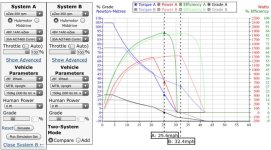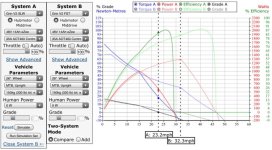E-HP said:
Interesting. So the lower current and higher resistance of the low KV motor is equal to the higher current and lower resistance of the high KV motor, when the same power is applied to the two motors with equal copper fill?
Imagine 2 light bulbs
- Assume each bulb flows 10A @ 10V = 100W each.
- With 2 bulbs in parallel, if you apply 10V then 20A will flow = 200W -> this is analogous to "1T", and is lower resistance.
- With 2 bulbs in series, if you put 20V then 10A will flow = 200W -> this is analogous to "2T", and is higher resistance.
- But see it is exactly the same power input.
- And exactly the same light/heat output.
- And exactly the same efficiency.
- Because the same 2 bulbs are each seeing the same power/current/voltage. They are just wired differently.
- So we conclude 1T=2T (=3T=4T=5T=6T=7T)
- Just different ratio of voltage and current.
- Same basic physics applies to motors (in this example, light is analogous to flux), assuming the same hardware (i.e. the same copper fill and motor structure)
- In the real world, minor differences may include different copper length in end turns, and main phase wire resistance.
- And often different windings do not end up with identical copper fill.
- But this is usually due to manufacturing limitations (i.e. wire diameter and number of strands used per winding not being divisible for all turn counts, etc).



